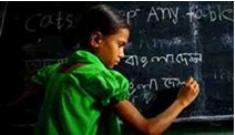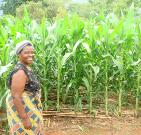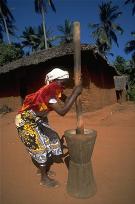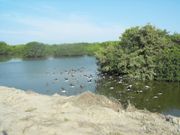Koliapara Village, Bangladesh
Kanika Chakraborty (Bangladesh), Susan Wasubire (Uganda), Lauriane Cayet (Reunion) and Doris Kaberia (Kenya) began developing a project with a disaster risk reduction component in Bangladesh in July.
| Challenges with safe water in flood-prone areas |
|
 |
After a participatory needs assessment they discovered that the 3,100 community members of Koliapara village are suffering from the loss of livelihoods, cattle, productive assets and land for cultivation due to increased flooding and cyclones. |
This DRR component, a participatory forest management program, will be aimed at building the resilience of the community and enhance their capacity to deal with the overreaching challenge of disrupted life style by the reoccurrence of disasters through planting trees along the river banks.
Participatory Riparian Forest Management Program [Solution to underlying causes: Climate variability causing increased incidence of flooding, cyclone and drought]:
[Activity 1]. Workshop & follow-up on consciousness raising about environmental services of riparian forests
[Activity 2]. Participatory forest management committee formation
[Activity 3]. Assessment of appropriate species for planting and locations for planting
[Activity 4]. Development of Participatory Forest Management Plan
[Activity 5]. Establish tree-seedling nursery
[Activity 6]. Workshops to plant trees in strategic areas
| Children are increasingly important in DRR programs & Disaster Preparedness Plans |
|
 |
Their project also includes a disaster preparedness program that will harmonize traditional with modern early warning systems
|
Disaster preparedness Program [solution to underlying cause Increase in the frequency and severity of floods triggered by the climate change]:
[Activity 1]. Community-based workshop and survey with community members to identify their knowledge of risk, vulnerability, and traditional coping techniques.
[Activity 2]. Organization of a community Disaster risk reduction Committee
[Activity 3]. Community workshop on community managed disaster risk reduction approaches (CMDRR) such as participatory mapping, Participatory risk assessment, Vulnerability analysis and Capacity Assessments (consciousness raising)
[Activity 4]. Community workshop on community contingency planning /preparedness for and responses to disasters.
[Activity 5]. Program on access to timely and reliable information and forecasts on the possible occurrence of natural calamities.
[Activity 6] Community workshop to harmonize traditional early warning systems and scientific early warning systems.
Download their report and needs assessment:
Needs assessment
Solution oriented project outline
Would you like to learn how to develop Community Based Adaptation Projects?
Please write us with your stories, thoughts and comments through Online.Learning@csd-i.org



